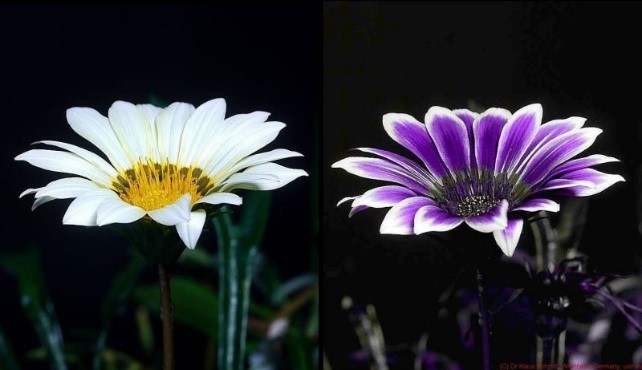British Science Week - The Electromagnetic Spectrum: Seeing Beyond our Eyes
The School of Physical and Chemical Sciences is celebrating British Science Week (11-20th March). British Science Week is a ten-day celebration of science, technology, engineering and maths, with the theme this year being 'Growth'. To celebrate his growth as a scientist, BSc Physics student Christopher wrote about a topic that really fascinates him; The Electromagnetic Spectrum.

Flower seen in visible light (left), and UV light (right).
(Klaus Schmitt, openphotographyforums.com)
One of the most important ways we learn about the world is through our sense of sight, which allows us to see using light. But what is light? Light is a type of wave that is a part of the electromagnetic spectrum, which itself is a type of energy that can take many forms – including visible light. These waves are useful in many ways, from x-rays being used in medical imagery to radio waves used in communications.
We can only see a small part of this wide spectrum, aptly called the visible light spectrum. These wavelengths of light that our retinas are sensitive to are what we use to perceive the world around us. But how would the world look if we could see other wavelengths in the electromagnetic spectrum? A good example is to look at Bees, which are able to see using ultraviolet light. Because they can see in a different part of the spectrum, they can see things, such as flowers, differently to how we can.
So how do we observe these wavelengths of light that are not naturally visible to us? To do this we need to use different types of detectors for different wavelengths. For longer wavelengths like radio waves and microwaves, we use satellite dishes. But for shorter wavelengths like ultraviolet and x-rays we use detectors similar to those in cameras.
These devices are useful as we are able to investigate things in a whole new way. Astronomers frequently image the night sky with different wavelengths which helps us understand the features of different objects in our universe. For example, stars emit light at all wavelengths across the electromagnetic spectrum, so imaging them at different wavelengths lets us see and investigate them in new ways.

The Crab nebula, imaged using different parts of the electromagnetic spectrum. (jodrellbank.net)
There are other uses of imaging these wavelengths that are beyond what we can see. Another example is infrared imaging, which has a variety of uses. When an infrared photo of a plant is taken, it will look different to what we see as the chlorophyll reflects infrared light very well. This can lead to images that look otherworldly, but is useful in detecting camouflage and for land survey purposes.
We can see that light is a very important way of observing the world around us. However there is a lot more light out there than what our eyes are able to detect, and this light allows us to discover things we might not have been able to before.
British Science Week Resources - https://www.britishscienceweek.org/
Our Undergraduate Courses - https://www.qmul.ac.uk/spcs/physics-and-astronomy/undergraduate/